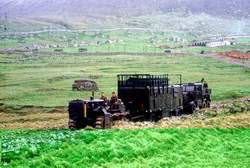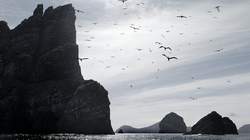Abandoned Communities ..... St Kilda
Despite their reservations every member of the community came to the conclusion it would be right to leave. Dugald Munro, the island's missionary or trainee clergyman, was asked to compose a letter to the Secretary of State for Scotland. All the adult members of the community put their signature to it, two of them doing so by placing a mark. The letter is reproduced in full by Tom Steel, who also provides a fascinating account of how the request to be evacuated was handled by politicians and officials in the Scottish Office, the Treasury, the Department of Health, the Department of Agriculture, the Department of Education, the Post Office, and the Forestry Commission.
Tom Steel, op. cit., chapter 13.
As it happens the plan for the evacuation was devised remarkably quickly. Part of the plan was that the sheep belonging to the islanders would be sold and the proceeds used to offset the costs of transporting the people and their belongings and starting the resettlement process. 667 sheep were collected on 6 August. About the same number again were removed on SS Dunara Castle on 28 August. That day the islanders made final preparations for their own departure, including killing their dogs by tying a stone round the neck of each dog and throwing it into the sea. The people left on 29 August, travelling aboard HMS Harebell.
At 7 o'clock that evening HMS Harebell reached Lochaline in Morvern, Argyll, and 27 people disembarked there. The remaining nine travelled on to Oban. Newspaper reporters had not been allowed to go to St Kilda to cover the evacuation, but they were present in large numbers to meet the group who went ashore at Lochaline. Recollections of this reception by some of the islanders are not complimentary.
The Forestry Commission arranged accommodation for the group who landed at Lochaline. In addition the Forestry Commission provided jobs for all the men of working age. There were no trees on Hirte, and it was envisaged that an initial period of training would be needed. Moreover, as they had never been in a position where they had to work for someone else they had to become familiar with the requirement to follow instructions. Tom Steel has described the suspicious attitudes of local residents towards the newcomers, the way in which the people from St Kilda adapted to their new circumstances, the financial difficulties suffered by several of them, and the varying emotional reactions they experienced.
Tom Steel, op. cit., chapter 14.
As the families were settled a few miles from each other it was not possible for them to go on giving each other the type of social support they had enjoyed on Hirte. One or two of the women seem to have felt especially isolated, having little or no company apart from a husband who was away at work throughout the day. On the other hand, the children appear to have adapted well, being excited by the novelty of so many things not seen before.
Those islanders who travelled on to Oban were then dispersed to various places. Several of them were particularly aggrieved at conditions in which they found themselves. They wrote repeated letters of complaint to the Scottish Office, a typical comment being that included in one letter from John Gillies, saying "This home is worse than the cattle byre I had in St Kilda. I understand from Nurse Barclay that we were to be situated in better homes, but this is worse than a dungeon hole."
Tom Steel has summarised the further difficulties faced by several of the St Kilda people over the following years, and the way they kept nostalgic memories of the island they had left, possibly for the rest of their lives.
Since 1956 St Kilda has been owned and managed by the National Trust for Scotland. It acquired World Heritage Status in 1986 by virtue of its exceptional natural beauty and for the important natural habitats that it supports. In 2003 the National Trust co-ordinated an application to UNESCO to gain World Heritage Status for the cultural significance of St Kilda too. The application was approved in July 2005.
Tom Steel, op. cit., chapter 13.
As it happens the plan for the evacuation was devised remarkably quickly. Part of the plan was that the sheep belonging to the islanders would be sold and the proceeds used to offset the costs of transporting the people and their belongings and starting the resettlement process. 667 sheep were collected on 6 August. About the same number again were removed on SS Dunara Castle on 28 August. That day the islanders made final preparations for their own departure, including killing their dogs by tying a stone round the neck of each dog and throwing it into the sea. The people left on 29 August, travelling aboard HMS Harebell.
At 7 o'clock that evening HMS Harebell reached Lochaline in Morvern, Argyll, and 27 people disembarked there. The remaining nine travelled on to Oban. Newspaper reporters had not been allowed to go to St Kilda to cover the evacuation, but they were present in large numbers to meet the group who went ashore at Lochaline. Recollections of this reception by some of the islanders are not complimentary.
The Forestry Commission arranged accommodation for the group who landed at Lochaline. In addition the Forestry Commission provided jobs for all the men of working age. There were no trees on Hirte, and it was envisaged that an initial period of training would be needed. Moreover, as they had never been in a position where they had to work for someone else they had to become familiar with the requirement to follow instructions. Tom Steel has described the suspicious attitudes of local residents towards the newcomers, the way in which the people from St Kilda adapted to their new circumstances, the financial difficulties suffered by several of them, and the varying emotional reactions they experienced.
Tom Steel, op. cit., chapter 14.
As the families were settled a few miles from each other it was not possible for them to go on giving each other the type of social support they had enjoyed on Hirte. One or two of the women seem to have felt especially isolated, having little or no company apart from a husband who was away at work throughout the day. On the other hand, the children appear to have adapted well, being excited by the novelty of so many things not seen before.
Those islanders who travelled on to Oban were then dispersed to various places. Several of them were particularly aggrieved at conditions in which they found themselves. They wrote repeated letters of complaint to the Scottish Office, a typical comment being that included in one letter from John Gillies, saying "This home is worse than the cattle byre I had in St Kilda. I understand from Nurse Barclay that we were to be situated in better homes, but this is worse than a dungeon hole."
Tom Steel has summarised the further difficulties faced by several of the St Kilda people over the following years, and the way they kept nostalgic memories of the island they had left, possibly for the rest of their lives.
Since 1956 St Kilda has been owned and managed by the National Trust for Scotland. It acquired World Heritage Status in 1986 by virtue of its exceptional natural beauty and for the important natural habitats that it supports. In 2003 the National Trust co-
Six
These two photographs were taken around 1960, when St Kilda was being used for military purposes.
They have been supplied by Ken Copeland.
Birds over St Kilda
Boreray
These two images appeared in the exhibition Lesions in the Landscape at FACT (Foundation for Art and Creative Technology) in Liverpool in the autumn of 2015.



